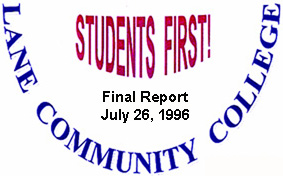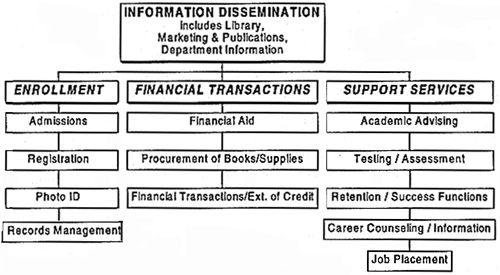| Lane Home Page | Search Lane |
| Website Accessibility |

STUDENTS FIRST! PROCESS REDESIGN Return to Change Proposal List SERVICE:
Current Situation: Lane provides a variety of services to students that are delivered by individual departments with functional specialties. Exhibit 1 below illustrates an overview of the service categories that the redesign team identified to describe services to students. Service categories include information dissemination, enrollment, financial transactions, and support services. Within each service category there are several process owners (i.e., primary providers) and additional providers (i.e., secondary providers). Appendix D-6 provides a detailed outline of each service category as well as process owners and additional providers. Responsibility for information dissemination is shared by most departments, Computer Services, and Institutional Advancement. Each department develops content information specific to its functional specialty and some departments also create their own publications. Computer Services provides programming to link information in electronic formats and make it accessible for employee use. Institutional Advancement collects department information, develops general College information, and oversees production of major publications (e.g. class schedule, catalog). Enrollment, which includes admissions, registration, records management, and photo ID, is handled by multiple process owners and additional providers. Provisions for admission and registration are dependent on the type of student (i.e., credit or non-credit), location of the service, and type of instructional program. Records are managed and maintained on a mainframe student database as well as individual databases. The photo ID is used primarily for charging a variety of services and usually obtained by credit students. The OSRL survey indicates that half of respondents possess an ID and those who do not are much more likely to be non-credit students than those who do (ninety-two percent compared to eight percent). Only thirty-six percent of the respondents without an ID are interested in obtaining one. Financial transactions include financial aid, the procurement of books and supplies, and the extension of credit. The administration of financial aid and procurement of books and supplies is handled primarily by process owners. Additional providers handle peripheral activities that are usually related to exceptions. Financial transactions are handled by one primary process owner (College Finance) and generated at multiple additional provider sites. The type of transaction is usually dependent on the location of where the goods or services are provided and whether the fees are registration related, non-registration related, or both. Support services are available to assist students with identifying both academic and personal goals, and provide students with resources that will ensure success. Support services include academic advising, testing, retention or success functions, career counseling, and job placement. The Counseling Department is the primary process owner of academic advising with several additional providers located on and off campus. Testing is conducted to assess skill levels, place students in appropriate classes, and determine a student's ability to benefit from a Lane education. While most testing is conducted at the main campus, some programs and instructional departments also administer tests. Retention (i.e., success) functions focus on individual student characteristics and needs. Job placement services are provided by a variety of additional providers who each focus on specific aspects of a student's career and work issues. Lane has been successful in meeting the needs of the various types of students it serves. According to the OSRL survey, sixty-eight percent of survey respondents indicated they are very satisfied with their overall experience with Lane services. However, Lane's efforts to meet student needs have resulted in specialized functions and a fragmentation of services. Service delivery is based on either individual function priorities, type of student (credit or non- credit), location of service, and/or student interest or need. Employee responsibilities are specialized with little cross-training within or between functions. The number of additional providers is evidence of each provider's attempts to accommodate their investment in serving students. This can lead to a stronger employee and student affiliation with the service instead of the college as a whole. There is minimal sharing of resources and coordination of services. This results in a duplication of effort and inconsistent delivery of service. During input sessions, employees commented on the inaccuracy and inaccessibility of information that could help them negotiate the various services and associated policies and procedures. Employees stated that they have created an informal network of individuals within functional areas to obtain information. Identifying the right individual is either by default or from experience. Also, if an employee leaves either temporarily or permanently, the network doesn't function. Some employees who are located off campus are disconnected from the main campus due to a lack of technological and information resources.

Desired Situation: Services to students are focused on processes and supported by a comprehensive organizational structure. Cross-functional teams deliver services in a central multi-purpose location and other College locations. Students have multiple service options including self- service through the use of technology. Employees have access to technology, receive broad- based training, and information rich support. Proposed Solution: The new services to students organization will be based on a desire to provide all: 1) students with the ability to conduct transactions in Žone-stop'; and 2) employees the training and skills to deliver services in a comprehensive, responsive manner. Refer to Appendix C-1 (Conceptual Design) for a conceptual overview of the services to students organization. Upon enrollment, both Lane and students want the student to have a successful experience. Employees with a general, broad-based knowledge base will be able to assist a majority of students with enrollment and identification of their goals. However, if a student encounters a barrier that requires technical expertise, an employee trained in that specific technical function will be available to assist the student. The type of service and information that students require is on a time continuum that spans short-term, general needs to long-term, goal related requirements. Services are delivered in a variety of ways including:
Students will have the option to select any method of service delivery with self-service as the desired method. However, Lane will recognize the importance of providing students options. Appendix C-2 (Student Characteristics and Access Points) illustrates the various student characteristics and access points that will be accommodated by a one-stop organization. Recognizing individual student characteristics and preferences for different methods of service, technology will be an important factor. Students will have physical and Žvirtual' access to services regardless of their goal (i.e. credit, non-credit). The organizational structure that will support the new services to students delivery system is outlined in Appendix C-3 (Organizational Structure). Features of the new structure include:
A Services to Students Team will be composed of the following: Information Team(s) Composed of individuals collecting and distributing information provided via: cable television, Lane's Wide Area Network (WAN), printed materials, student database, telephone, and World Wide Web (WWW)
Students First! Center Team which includes:
Advising, Counseling, and Career Development Team which includes:
Support and Diversity Team(s) Composed of Black Student Union, Disability Services, International Student Services, Multi- Cultural Center, Native American Student Association, Substance Abuse Prevention Services, Women's Programs A Services to Students Process Owner Manager will manage each of the following:
Finally, a member of the Executive Leadership Team will manage the Services to Students Process Owner Managers. With the shift in focus from a specialized, stovepipe organization to a cross-functional, team-based organization, employee skills and responsibilities will be dramatically changed. Appendix C-4 (Team Skills, Characteristics, and Responsibilities) outlines the skills and characteristics that are considered essential for teams to function effectively. The skills, characteristics, and responsibilities are intended as guidelines for developing job descriptions and identifying individuals for specific teams. Team skills training and an acknowledgment of shared accountability will be essential to the success of individual teams. Leadership and commitment to change are also essential elements. Pages 1-2 of Appendix C-4 include a summary of common skills, characteristics, and responsibilities for the Students First! Center Team. One particular group of individuals that will be directly impacted are managers. Managers will be expected to function as a process owner manager or team leader manager, new distinctions in the organizational structure and Lane environment. Manager roles will change from supervisor to coach and facilitator (e.g., provide suggestions instead of mandates). For a summary of common skills, characteristics, and responsibilities for the Services to Students Process Owner Manager, refer to page 3 of Appendix C-4 and page 4 for the Team Leader Managers for the Students First! Center and Advising, Counseling, and Career Development Team. In order for each team to be successful, common performance goals and evaluation criteria will be established. Page 5 of Appendix C-4 includes a summary of evaluation criteria and the evaluation process. Both will apply to the individual and team.
Coach: Linda DeWitt, Kay Malmberg, Carol Lynn Morse, Sharon Williams
Action Plan for Implementing Solution:
|
>> Return to Lane's Home Page >> Return to Process Redesign Project Main Page >> Return to top of page Lane Community College - Process Redesign Project 4000 East 30th Avenue, Eugene, OR 97405 Please direct comments about this site to webmaster@lanecc.edu Revised 12/2/96 (llb) © 1996-present Lane Community College |
